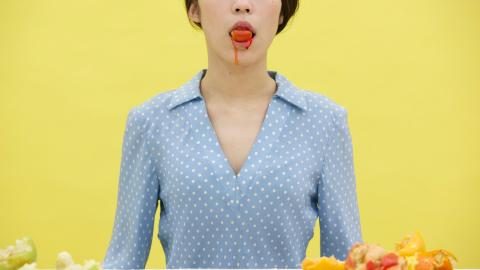Hou I-Ting
APT9
Born 1979 Kaohsiung City, Taiwan
Lives and works in Taipei, Taiwan
Hou I-Ting works across video, performance and altered photography, often with a focus on women’s labour. The contrast between individual expression and repetitive processes of production, and personal and collective histories, are interwoven in her practice. I-Ting considers the ways in which a succession of colonial and political regimes in Taiwan have determined the role of women in the workforce, and on the particular products associated with female labour. In a series of works on paper, she used brightly coloured embroidery to contrast with black and white historical images of Taiwanese women at work in a production line. For her performance-based installation, Sewing Fields, she recreated a labour force of embroiderers in the gallery for the duration of the exhibition. A recent group of works has concentrated on food production, particularly the monotonous preparation of elaborate Bento boxes for Taiwanese railway passengers, which has taken place in the same factory for 70 years.

In White uniform 2017, Hou I-Ting examines women’s work in creating a Taiwanese variant of the bento box. Known as bendong in Taiwanese Hokkien and biantang in Mandarin, these boxed lunches have persisted as a cultural legacy of Japanese occupation. Consisting of a short film and a series of photographs, the work was produced in collaboration with the employees of the Taiwan Railways Administration kitchen in Qidu, near Taipei.
The film focuses on a group of women as they use stencils to finely cut sheets of seaweed to be placed over rice, reproducing historical designs from the covers of bendong boxes. These designs, documented in the accompanying photographs, were created during the Japanese colonial period (1895–1945), a time when Taiwan’s railway was intensively developed to facilitate the transportation of natural resources for export. Most designs are innocuous, their Japanese text advertising sandwiches, chicken lunches or bananas from Taichung; however, others are more ambiguous and include wartime propaganda.
Intercutting historical footage of rail travel with interviews with staff members and their supervisor, Hou’s film recalls the tendency of the mind to wander during long journeys and repetitive work. White uniform addresses the intricacies of sexual difference and labour relations, colonialism and national identity, collective history and personal memory, all through the simple enjoyment of a packed lunch on a long train ride.

White Uniform 2017
- HOU I-Ting - Creator

White Uniform No.1 2017
- HOU I-Ting - Creator

White Uniform No.2 2017
- HOU I-Ting - Creator

White Uniform No.3 2017
- HOU I-Ting - Creator

White Uniform No.4 2017
- HOU I-Ting - Creator

White Uniform No.5 2017
- HOU I-Ting - Creator

White Uniform No.6 2017
- HOU I-Ting - Creator

White Uniform No.7 2017
- HOU I-Ting - Creator
